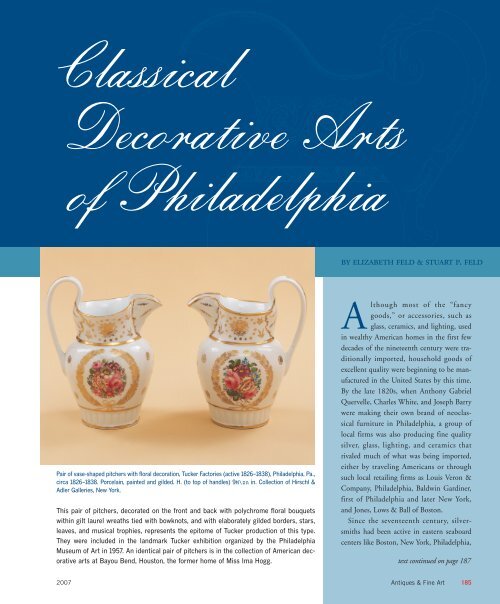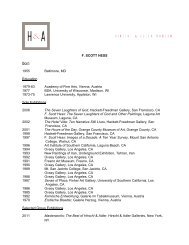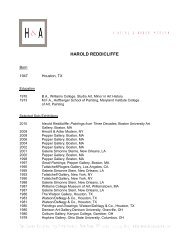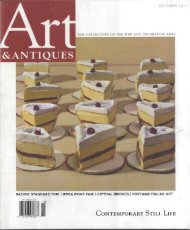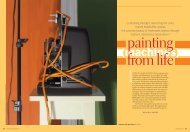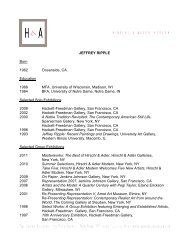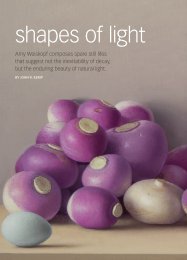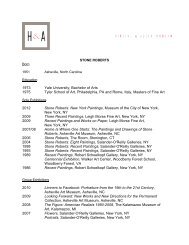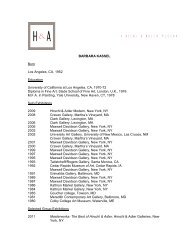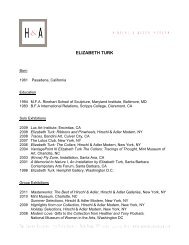Download PDF - Hirschl & Adler Galleries
Download PDF - Hirschl & Adler Galleries
Download PDF - Hirschl & Adler Galleries
Create successful ePaper yourself
Turn your PDF publications into a flip-book with our unique Google optimized e-Paper software.
Classical<br />
Decorative Arts<br />
of Philadelphia<br />
Pair of vase-shaped pitchers with floral decoration, Tucker Factories (active 1826–1838), Philadelphia, Pa.,<br />
circa 1826–1838. Porcelain, painted and gilded. H. (to top of handles) 9M\zn in. Collection of <strong>Hirschl</strong> &<br />
<strong>Adler</strong> <strong>Galleries</strong>, New York.<br />
This pair of pitchers, decorated on the front and back with polychrome floral bouquets<br />
within gilt laurel wreaths tied with bowknots, and with elaborately gilded borders, stars,<br />
leaves, and musical trophies, represents the epitome of Tucker production of this type.<br />
They were included in the landmark Tucker exhibition organized by the Philadelphia<br />
Museum of Art in 1957. An identical pair of pitchers is in the collection of American decorative<br />
arts at Bayou Bend, Houston, the former home of Miss Ima Hogg.<br />
by elizabeth feld & stuart p. feld<br />
Although most of the “fancy<br />
goods,” or accessories, such as<br />
glass, ceramics, and lighting, used<br />
in wealthy American homes in the first few<br />
decades of the nineteenth century were traditionally<br />
imported, household goods of<br />
excellent quality were beginning to be manufactured<br />
in the United States by this time.<br />
By the late 1820s, when Anthony Gabriel<br />
Quervelle, Charles White, and Joseph Barry<br />
were making their own brand of neoclassical<br />
furniture in Philadelphia, a group of<br />
local firms was also producing fine quality<br />
silver, glass, lighting, and ceramics that<br />
rivaled much of what was being imported,<br />
either by traveling Americans or through<br />
such local retailing firms as Louis Veron &<br />
Company, Philadelphia, Baldwin Gardiner,<br />
first of Philadelphia and later New York,<br />
and Jones, Lows & Ball of Boston.<br />
Since the seventeenth century, silversmiths<br />
had been active in eastern seaboard<br />
centers like Boston, New York, Philadelphia,<br />
text continued on page 187<br />
2007 Antiques & Fine Art 185
186 www.antiquesandfineart.com<br />
Monumental urn depicting two<br />
dramatic scenes, Tucker Factories<br />
(active 1826–1838), Philadelphia, Pa.,<br />
circa 1832–1838. Porcelain, painted<br />
and gilded, with applied gilt-bronze<br />
handles, and an iron and brass tie-rod<br />
for assembly. H. 22, D. 8˙,<br />
W. (through the handles) 12∆ in.<br />
Collection of <strong>Hirschl</strong> & <strong>Adler</strong><br />
<strong>Galleries</strong>, New York.<br />
This vase, depicting two dramatic<br />
scenes painted in polychrome, is<br />
one of the six largest and most<br />
elaborate pieces known to have<br />
been produced by the Tucker<br />
Factories. Two identical pairs of<br />
vases, one with views of the<br />
Schuylkill waterworks and dam at<br />
Fairmount, Philadelphia, and a<br />
second with floral decoration, are<br />
in the collection of the<br />
Philadelphia Museum of Art, while<br />
a sixth vase with views of Sedgley<br />
and a view from Springland, the<br />
printmaker William Birch’s estate<br />
on the Delaware River, is in a<br />
rivate collection.<br />
Spring
text continued from page 185<br />
and Baltimore. But in the neoclassical<br />
period of the early nineteenth century,<br />
Philadelphia emerged as the center of<br />
the silver trade in the United States,<br />
with Fletcher and Gardiner (and<br />
Thomas Fletcher working alone after<br />
Sidney Gardiner’s death in 1827),<br />
Simon Chaudron, Anthony Rasch,<br />
Harvey Lewis, and Edward Lownes<br />
turning out silver of extraordinary<br />
quality. Drawing upon English Regency<br />
and French Empire prototypes, these<br />
and other silversmiths created a distinct<br />
Philadelphia style that stands apart, stylistically<br />
and qualitatively, from silver<br />
made elsewhere in the United States at<br />
the time. They worked not only for a<br />
local market, but for clients at a considerable<br />
distance as well. For example,<br />
Fletcher and Gardiner, who started out<br />
in Boston in 1808 before moving to<br />
Philadelphia in 1811, continued to<br />
serve Bostonians for another generation,<br />
and Anthony Rasch was called upon to<br />
execute the plate for the elaborate residence<br />
that David and Miriam Sears<br />
built at 42 Beacon Street, Boston, about<br />
1819.<br />
In the ceramics field, a profusion of<br />
French and English porcelain, both utilitarian<br />
and decorative, was imported, as<br />
very little porcelain was made in the<br />
United States until the second quarter<br />
of the nineteenth century, when the<br />
Tucker Factories of Philadelphia began<br />
operation in 1826 and became the first<br />
moderately successful manufacturer of<br />
porcelain in the United States. They<br />
produced a wide variety of table and<br />
ornamental wares, from small, generic,<br />
and practical pieces, with little or no<br />
ornamentation, to larger, more carefully<br />
crafted decorative objects inspired by<br />
English Regency and French “Old Paris”<br />
prototypes.<br />
Lighting, too, was a major import<br />
text continued on page 191<br />
Pair of small columnar sinumbra lamps, Cornelius & Company (active 1827–1831), Philadelphia, Pa., circa<br />
1827–1831. Gilt bronze and brass, with lamp mechanism and glass shades, blown, frosted, and wheel cut, and<br />
glass chimneys. H. (to top of chimneys) 19¬ in. Signed (on upper side of the iron weight mounted under the<br />
base of each): “C C C 90.” Collection of <strong>Hirschl</strong> & <strong>Adler</strong> <strong>Galleries</strong>, New York.<br />
This pair of miniature sinumbra lamps, looking to English designs of the early to mid-1820s<br />
that were largely made in the metalworking center of Birmingham, England, stands at the<br />
beginning of the production of lighting by the Cornelius firm. Another signed pair, looking<br />
more to a French prototype, is in the collection of the Art Institute of Chicago. Other American<br />
manufacturers of lamps of this type were the New England Glass Company of Cambridge,<br />
Massachusetts, and William Carleton of Boston.<br />
2007 Antiques & Fine Art 187
Pair of Argand lamps, Cornelius & Son (active<br />
1831–39), Philadelphia, Pa., about 1835. Gilt bronze<br />
and brass, with lamp mechanism and glass shades,<br />
blown, frosted, and wheel cut, and glass chimneys.<br />
H. 20˙, W. 11 in. Courtesy of Carswell Rush Berlin,<br />
New York.<br />
Pair of double Argand lamps, Thomas Messenger &<br />
Sons, Birmingham, England (active 1797–1920), circa<br />
1830. Retailed by Louis Veron & Company,<br />
Philadelphia, Pa. Inscribed (with embossed brass<br />
label applied to tube): LOUIS VERON & Co. /<br />
PHILADELPHIA. Courtesy of Carswell Rush Berlin,<br />
New York.<br />
For many years, the presence of brass labels<br />
embossed with American names on a substantial<br />
number of Argand lamps led to the<br />
assumption that these lamps were actually<br />
made in the United States. The discovery,<br />
however, of manufacturers’ names cast into<br />
internal weights and other hidden parts has<br />
confirmed that many of them were made<br />
abroad, by such firms as Thomas Messenger<br />
& Sons of Birmingham, England, and were<br />
visibly marked with the names of their intended<br />
American retailers. The retailer of this pair<br />
of lamps (lower right) was French émigré<br />
Louis Veron, a purveyor of fashionable furnishings<br />
on Chestnut Street in Philadelphia.<br />
Veron was also an interior designer and was<br />
responsible for the 1829 redecoration of the<br />
East Room in the White House during Andrew<br />
Jackson’s administration.<br />
188 www.antiquesandfineart.com<br />
Bread basket, Thomas Fletcher (1787–1866) and Sidney Gardiner<br />
(1785/7–1827), Philadelphia, Pa. (active together 1811–1827),<br />
circa 1815–1820. Silver. L. 16∆, W. 8¬, H. 4© in. Signed and<br />
inscribed (on the bottom, twice): FLETCHER & GARDINER / PHI-<br />
LADA. Collection of <strong>Hirschl</strong> & <strong>Adler</strong> <strong>Galleries</strong>, New York.<br />
Fletcher & Gardiner of Philadelphia was the leading silversmithing<br />
firm in America during the later neoclassical<br />
period. Following Sidney Gardiner’s early death in 1827,<br />
Thomas Fletcher worked alone. Among the most interesting<br />
pieces they produced were baskets of a variety of<br />
shapes, of which only about a dozen examples have been<br />
recorded. This basket follows the unusual shape of a pair<br />
of baskets (at the Maryland Historical Society) that are<br />
included in the service made by Fletcher and Gardiner in<br />
1817 for presentation by the citizens of Baltimore to<br />
Commodore John Rogers for his heroic acts in the<br />
successful defense of Baltimore during the War of 1812.<br />
Spring
Thomas Fletcher, Design for a water pitcher, circa<br />
1835. Pen and brown ink on cream wove paper. 19µ<br />
x 12 in. Courtesy of The Metropolitan Museum of Art.<br />
The Elisha Whittelsey Collection; The Elisha<br />
Whittelsey Fund. 1953 (53.652.20). Image © The<br />
Metropolitan Museum of Art.<br />
Following the early death of Sidney Gardiner<br />
in 1827, Thomas Fletcher continued to produce<br />
silver of ultimate quality. This ewer is<br />
almost identical to one depicted in a drawing<br />
from the Fletcher & Gardiner / Thomas<br />
Fletcher firm in the collection of the<br />
Department of Drawings and Prints at The<br />
Metropolitan Museum of Art, New York<br />
(above). The ewer differs from the drawing in<br />
its absence of the band of scrolls, probably<br />
intending to be repousséd (“chased,” as the<br />
drawing notes) that encircles the neck of the<br />
ewer in the drawing. Also missing are the<br />
inverted leaves around the stem of the base.<br />
Fletcher, anticipating that his clientele might<br />
like to determine the amount of ornamentation,<br />
specified, at the right of the drawing,<br />
the variations he could provide: “45 oz. each<br />
… $2.50 chased,” or “40 oz. each … at $2.25<br />
plain neck and foot,” as per the present<br />
example, which weighs, not surprisingly, 39<br />
troy oz. 8 dwts. But the shape of the ewer is<br />
identical, and the band of acanthus leaves<br />
around the body and the four die-rolled borders<br />
that encircle the lip, the shoulder, the<br />
stand, and the base are all exactly the same.<br />
Ewer, Thomas Fletcher (1787–1866; active 1827–42), Philadelphia, Pa., circa 1838. Silver. H. 13˙ in. Signed and<br />
inscribed (with seal mark on the bottom): •T. FLETCHER•PHILAD. Inscribed (with engraving on inside rim of<br />
base): “From E. Carmick to Minerva Cenas. 1838.” Collection of <strong>Hirschl</strong> & <strong>Adler</strong> <strong>Galleries</strong>, New York.<br />
2007 Antiques & Fine Art 189
Five piece tea/coffee service, Edward Lownes<br />
(1792–1834) and Henry Erwin, Philadelphia, Pa.<br />
(active as a partnership, 1816–17), circa 1816–1817.<br />
Silver Coffee pot: H. 9˙ in. Signed (with touch on two<br />
pots and waste bowl): H. ERWIN; (on covered sugar<br />
bowl and creamer): E.LOWNES. Inscribed (with<br />
engraving, on the front of each piece): MWE.<br />
Collection of <strong>Hirschl</strong> & <strong>Adler</strong> <strong>Galleries</strong>, New York.<br />
This five piece coffee/tea service, consisting<br />
of a coffee pot, tea pot, covered sugar bowl,<br />
creamer, and waste bowl variously marked<br />
by Erwin and Lownes, is testimony to their<br />
short-lived partnership in the years<br />
1816–1817. Henry Erwin is listed in the<br />
Philadelphia directories from 1817 to 1829 as<br />
a “silversmith” and in the period 1837 to<br />
1842 as a “watchmaker.” This set, with its<br />
considerable weight, its finely cast and<br />
wrought eagle spouts on the coffee and tea<br />
pots, and finials and medallions on the covers<br />
of the two pots and the sugar bowl, and<br />
its exquisite die-rolled borders, is typical of<br />
the best of Philadelphia production of the<br />
second decade of the nineteenth century.<br />
190 www.antiquesandfineart.com<br />
Pair of clear glass fluid lamps, attributed to Union Flint Glass Works,<br />
Kensington, Philadelphia, Pa., circa 1835–1840. Glass, pressed and<br />
blown, cut and engraved, with brass collars. H. (to the top of the brass<br />
collars) 10˙ in. Collection of the Art Institute of Chicago. Photograph<br />
courtesy of <strong>Hirschl</strong> & <strong>Adler</strong> <strong>Galleries</strong>, New York.<br />
Very little is known about cut glass made in the United<br />
States during the period 1810–1840. The documentation of<br />
a group of early blown and cut glass formerly at the<br />
Albany Institute of History and Art, Albany, New York, and<br />
now at the Corning Museum of Glass, Corning, New York,<br />
allows us to attribute the superb cutting found on a group<br />
of lamps, including the present examples—long assumed<br />
to be of New England origin—to the Union Flint Glass<br />
Works, also known as the Union Glass Works, and the<br />
Union Cut and Plain Glass Flint Glass Works, Philadelphia.<br />
This glass house, which is known to have produced blown,<br />
pressed, and cut glassware, specimens of which were<br />
exhibited at the Franklin Institute, Philadelphia, in 1827<br />
and 1831, was founded in 1826, and dissolved in 1844,<br />
after having operated at a site in the Kensington section of<br />
Philadelphia on the Delaware River.<br />
Spring
text continued from page 187<br />
during the neoclassical period, with retailers<br />
offering a variety of wares, some from<br />
France but mostly from the metalworking<br />
center of Birmingham, England. But, again,<br />
locally Cornelius & Company of<br />
Philadelphia began operating in 1827, producing<br />
lighting fixtures first in a neoclassical<br />
mode and, later, in a succession of eclectic<br />
Victorian styles. Similarly, in 1826, the<br />
Union Flint Glass Company was founded in<br />
Philadelphia by glass men who had previously<br />
worked in Boston and New York.<br />
They produced blown and cut wares that<br />
rivaled those hitherto largely imported from<br />
England and Ireland.<br />
Thus, during the early decades of the<br />
nineteenth century, the craftsmen and<br />
industries of Philadelphia became serious<br />
contributors and competitors in the marketplace<br />
for household decorative arts. The<br />
examples in this article offer a selection of<br />
objects that were produced locally, or, in one<br />
instance, made abroad on order for a<br />
Philadelphia retailer.<br />
Father-daughter team Stuart P. Feld and<br />
Nicolino Calyo<br />
(1799–1884),<br />
View of<br />
Philadelphia from<br />
Camden, New<br />
Jersey, circa 1838.<br />
Gouache on paper,<br />
6˚ x 8µ inches.<br />
Inscribed (across<br />
the bottom):<br />
“Philadelphia,<br />
from Camden.”<br />
Collection of<br />
<strong>Hirschl</strong> & <strong>Adler</strong><br />
<strong>Galleries</strong>, New York.<br />
Born in Naples, Italy, Nicolino Calyo found his way to America in search of artistic opportunity. His meticulously rendered works, in the precise<br />
topographical tradition of his time, closely captured the people and places of his travels. The present work, one of a series of cabinet-size<br />
gouaches that explores both a particular place as well as a narrative scene, is taken from the New Jersey side of the Delaware River, at the<br />
Camden terminus of the Camden-Philadelphia ferry, and shows, in miniature, a panoramic view of the Philadelphia skyline stretching peacefully<br />
along the riverfront.<br />
Elizabeth Feld own and run <strong>Hirschl</strong> &<br />
<strong>Adler</strong> <strong>Galleries</strong>, New York, where they<br />
specialize in important American and<br />
European paintings of all periods and<br />
American decorative arts of the nineteenth<br />
century. They have curated several pivotal<br />
exhibitions on American decorative arts,<br />
accompanied by scholarly publications<br />
including Boston in the Age of Neo-<br />
Classicism, 1810–1840 and In Pointed<br />
Style: The Gothic Revival in America.<br />
Both Felds are themselves collectors of<br />
American Neo-Classical decorative arts.<br />
2007 Antiques & Fine Art 191


